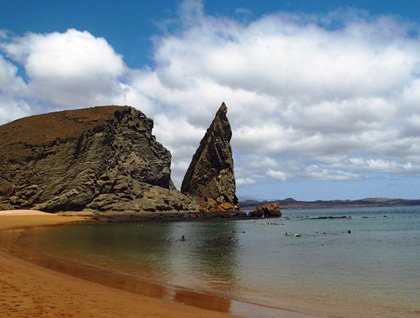Our day began early as our oceanic limousines (Zodiacs) met us at the Endeavour so we could explore Bartolome, an amazing volcanic islet off the coast of Santiago Island. There were several options available, depending on preferred levels of intensity. Those feeling ambitious disembarked early for a hike up the Bartolome Islet, while others explored the islet by Zodiac. At the entrance of the trail, hikers were greeted by a stationary iguana. Once on the trail, hikers climbed the 372 steps to the top of the summit, while the naturalists explained the impressive geologic features of the islet. A variety of types of lava samples were witnessed, including “aa” and “pahoe-hoe” and several spatter and cinder cones. Naturalists explained that the northern slope of each of the volcanic cones is steeper due to the southerly prevailing wind. As hikers took in the breathtaking view once they reached the top of the summit, they saw evidence of the lava rivers that once oozed from the vents and deep underwater craters. This site is one of the most photographed locations in the Galapagos and it provides a geological field study because it truly reflects the volcanic activity of the Galapagos archipelago.
After breakfast, guests explored the subterranean world as they snorkeled or sailed on the glass water boats. Galapagos penguins perched on rocks just near the shore. Many species of the underwater world were spotted such as the blue-chin parrotfish, lobsters, chocolate chip sea stars, sharks, blue and golden striped snappers, diamond stingrays, trumpet fish, yellow-tailed razor fish, and several large species of the Panamic cushion sea star. A mob of yellow tail razor fish pillaged algae from a school of damsel fish, while one damsel tried, unsuccessfully, to ward off the invaders at his underwater farm. A few fortunate snorkelers took in the breathtaking view of a six-foot white-tailed shark.
After a delicious lunch of shishkabobs, quinoa, and other local fare, guests had the opportunity to attend a book signing of a collection of bedtime stories and field guides written by two of the naturalists. Afterwards, there was the option of attending the final “Paper to Pearls” workshop and art lesson. Guests reconvened in the lounge to listen to the underwater specialist provide with us with a brief lesson in oceanography. During his engaging lecture, we learned about the Gyre current, which causes the Coriolis Effect. He also talked about the impact that El Niño has had on the species of the islands. Interestingly, Australia and Galápagos are most affected by this natural event. In 1997, the last major El Niño occurred. At that time, nearly seventy percent of the marine iguanas died because their food source was altered. Currently, ocean temperatures in the archipelago are five degrees warmer than normal. The anticipated super El Niño appears to be on its way.
Our afternoon was devoted to exploring Sombrero Chino and the Bainbridge Islets which are small volcanoes. Avid snorkelers had the opportunity to explore the area while others opted for the late zodiac ride. In order to avoid being pestered by pelicans, several penguins dove into the water with the snorkelers. Sharks were seen in open water as well as hiding in underwater caverns. Zodiac riders circled the shoreline and saw several penguins and crabs as the pelicans dove around them. The night ended with a barbecue dinner on the bridge of the ship as the National Geographic Endeavor crossed over the equator.
Once again we felt like true explorers as we witnessed the isolation that makes Galápagos so dramatic.








